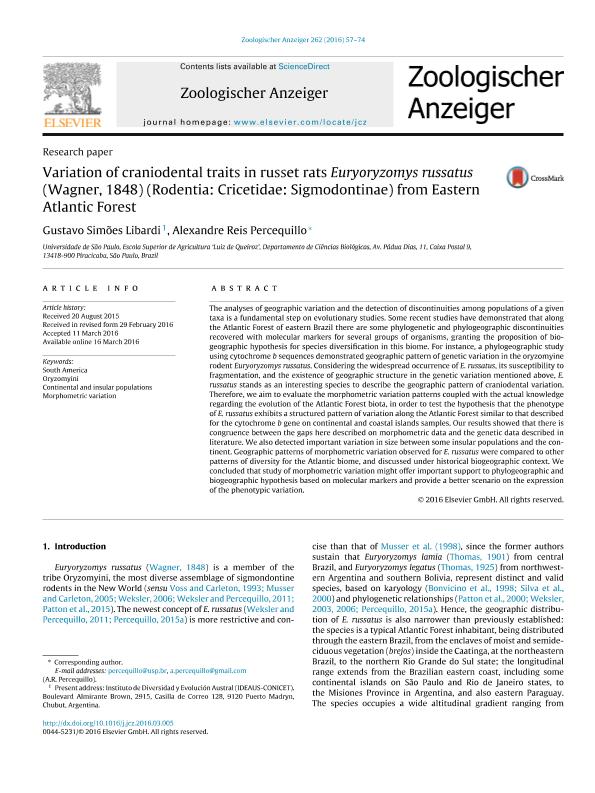Mostrar el registro sencillo del ítem
dc.contributor.author
Simoes Libardi, Gustavo

dc.contributor.author
Reis Percequillo, Alexandre

dc.date.available
2018-02-16T20:10:06Z
dc.date.issued
2016-05
dc.identifier.citation
Simoes Libardi, Gustavo; Reis Percequillo, Alexandre; Variation of craniodental traits in russet rats Euryoryzomys russatus (Wagner, 1848) (Rodentia: Cricetidae: Sigmodontinae) from Eastern Atlantic Forest; Elsevier Gmbh; Zoologischer Anzeiger; 262; 5-2016; 57-74
dc.identifier.issn
0044-5231
dc.identifier.uri
http://hdl.handle.net/11336/36663
dc.description.abstract
The analyses of geographic variation and the detection of discontinuities among populations of a given taxa is a fundamental step on evolutionary studies. Some recent studies have demonstrated that along the Atlantic Forest of eastern Brazil there are some phylogenetic and phylogeographic discontinuities recovered with molecular markers for several groups of organisms, granting the proposition of biogeographic hypothesis for species diversification in this biome. For instance, a phylogeographic study using cytochrome b sequences demonstrated geographic pattern of genetic variation in the oryzomyine rodent Euryoryzomys russatus. Considering the widespread occurrence of E. russatus, its susceptibility to fragmentation, and the existence of geographic structure in the genetic variation mentioned above, E. russatus stands as an interesting species to describe the geographic pattern of craniodental variation. Therefore, we aim to evaluate the morphometric variation patterns coupled with the actual knowledge regarding the evolution of the Atlantic Forest biota, in order to test the hypothesis that the phenotype of E. russatus exhibits a structured pattern of variation along the Atlantic Forest similar to that described for the cytochrome b gene on continental and coastal islands samples. Our results showed that there is congruence between the gaps here described on morphometric data and the genetic data described in literature. We also detected important variation in size between some insular populations and the continent. Geographic patterns of morphometric variation observed for E. russatus were compared to other patterns of diversity for the Atlantic biome, and discussed under historical biogeographic context. We concluded that study of morphometric variation might offer important support to phylogeographic and biogeographic hypothesis based on molecular markers and provide a better scenario on the expression of the phenotypic variation.
dc.format
application/pdf
dc.language.iso
eng
dc.publisher
Elsevier Gmbh

dc.rights
info:eu-repo/semantics/openAccess
dc.rights.uri
https://creativecommons.org/licenses/by-nc-sa/2.5/ar/
dc.subject
Continental And Insular Populations
dc.subject
Morphometric Variation
dc.subject
Oryzomyini
dc.subject
South America
dc.subject.classification
Otras Ciencias Biológicas

dc.subject.classification
Ciencias Biológicas

dc.subject.classification
CIENCIAS NATURALES Y EXACTAS

dc.title
Variation of craniodental traits in russet rats Euryoryzomys russatus (Wagner, 1848) (Rodentia: Cricetidae: Sigmodontinae) from Eastern Atlantic Forest
dc.type
info:eu-repo/semantics/article
dc.type
info:ar-repo/semantics/artículo
dc.type
info:eu-repo/semantics/publishedVersion
dc.date.updated
2018-02-15T16:54:40Z
dc.journal.volume
262
dc.journal.pagination
57-74
dc.journal.pais
Alemania

dc.journal.ciudad
Berlín
dc.description.fil
Fil: Simoes Libardi, Gustavo. Consejo Nacional de Investigaciones Científicas y Técnicas. Centro Científico Tecnológico Conicet - Centro Nacional Patagónico. Instituto de Diversidad y Evolución Austral; Argentina. Universidade de Sao Paulo; Brasil
dc.description.fil
Fil: Reis Percequillo, Alexandre. Universidade de Sao Paulo; Brasil
dc.journal.title
Zoologischer Anzeiger

dc.relation.alternativeid
info:eu-repo/semantics/altIdentifier/url/http://www.sciencedirect.com/science/article/pii/S0044523116300146
dc.relation.alternativeid
info:eu-repo/semantics/altIdentifier/doi/https://doi.org/10.1016/j.jcz.2016.03.005
Archivos asociados
